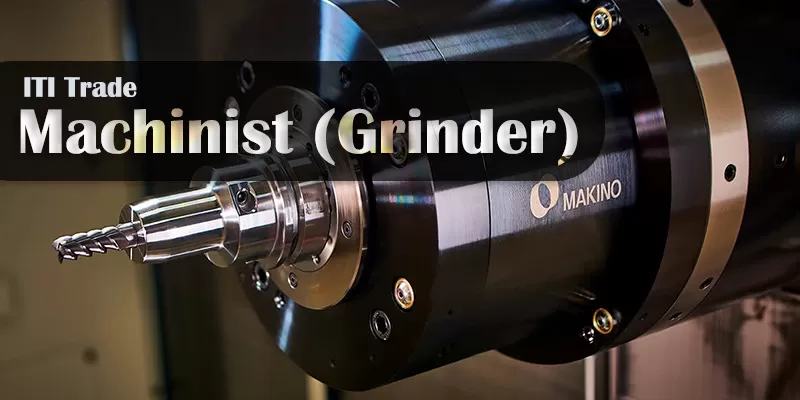
ITI Trade: Machinist (Grinder)
Powered by: NCVT (National Council for Vocational Training)
Course Duration: 2 Years (Four Semesters)
NSQF Level: 5
Mode: Full-time
Overview
The ITI Machinist (Grinder) trade, under the Craftsmen Training Scheme (CTS), is a job-oriented and skill-based course powered by NCVT. It is specifically designed to meet the industrial demands of Indian as well as International industries.
The Machinist (Grinder) trade is highly suitable for those aiming for government jobs, private sector jobs, and self-employment. The course empowers candidates with specialized skills in precision grinding operations, tool re-sharpening, surface finishing techniques, and machine maintenance, making them valuable assets in the manufacturing and production sectors.
Scope of Employability
Graduates of the Machinist (Grinder) trade have a wide scope of employability, including:
- Self-employment
- Contractual employment
- Government and Private Sector Jobs
Typical Job Roles
- Grinder, General
- Surface Grinder Operator
- Roll Grinder
- Honer / Honing Machine Operator
- Lapper
- Grinder (Tool and Cutter)
- Employment opportunities in Public Sector Units (PSUs), Private Industries in India and Abroad
International Comparability
- There is no official document suggesting direct comparability with qualifications from other countries.
- However, ITI Machinist (Grinder) graduates have gained employment opportunities in countries like:
- Gulf Countries
- Europe
- Australia & New Zealand
- Singapore, etc.
Progression Pathways
Upon completing the ITI Machinist (Grinder) course, candidates can:
✔ Appear for 10+2 examinations through the National Institute of Open Schooling (NIOS), enabling them to pursue higher secondary education.
✔ Gain lateral entry into diploma courses in relevant engineering fields.
✔ Enroll in Apprenticeship Programs across industries leading to the National Apprenticeship Certificate (NAC).
✔ Join the Crafts Instructor Training Scheme (CITS) to become vocational instructors in ITIs and other vocational training institutes.
Semester-wise Curriculum & Learning Outcomes
Semester I
- Plan and organize work to manufacture components as per specifications applying various basic fitting operations and checking dimensional accuracy.
(Operations include: marking, hack sawing, chiseling, filing, drilling) - Produce simple components by setting different machine parameters and performing lathe operations such as facing, plain turning, taper turning, boring, and simple thread cutting.
- Perform grinding wheel mounting, balancing, dressing, truing, and set up surface grinders for rough and finish grinding.
(Accuracy limit: ±0.25 mm) - Set cylindrical grinders to produce components by performing external and internal cylindrical grinding operations.
(Accuracy limit: ±0.25 mm)
Semester II
- Set up cylindrical grinders for automatic movement and perform various grinding operations such as straight parallel grinding, taper grinding, bush eccentric grinding using different machine accessories.
- Perform dry and wet grinding on different shaped jobs (square blocks, angle plates, angular blocks) made from various metals (cast iron, steel).
(Accuracy limit: ±0.02 mm) - Perform bore grinding and check accuracy with telescopic gauges.
- Perform operations on tool and cutter grinders, including re-sharpening different tools on a pedestal grinder (lathe tools, drill bits, tool bits).
- Manufacture components with angular and straight surfaces, checking for accuracy using sine bars, slip gauges, and dial test indicators (DTI).
- Perform preventive maintenance of grinding machines such as surface and cylindrical grinders.
- Perform cylindrical parallel grinding of different materials (soft & hard metals).
(Accuracy limit: ±0.01 mm)
Semester III
- Re-sharpen different milling cutters, including plain and slitting saw cutters.
- Produce components with straight and angular surfaces, working to close tolerance limits.
(Components: V block, plain cylindrical bar, cube. Tolerance: ±0.01 mm) - Manufacture gauges (snap gauges, ring gauges) and check them using appropriate instruments.
(Tolerance: H7/h7) - Produce components from non-ferrous metals (e.g., taper pins, rectangular bars).
(Accuracy limit: ±0.01 mm) - Perform cylindrical angular grinding operations to produce lathe centers and milling machine arbors.
(Accuracy limit: h6 or H6)
Semester IV
- Prepare component surfaces using honing operations.
(Accuracy limit: ±0.001 mm) - Perform taper grinding operations, including compound/double taper, steep taper, Morse taper.
(Accuracy limit: ±0.008 mm) - Produce male and female components using different grinding methods, including step and slot grinding.
(Tolerance limit: H6/h5) - Perform lapping and buffing on surfaces to achieve close limit h5.
- Manufacture components using various grinding techniques, including cylindrical taper grinding, surface grinding, and shoulder grinding.
(Tolerance limit: h6) - Identify different components of CNC lathe machines, understand their function, and prepare part programs using simulation software.
- Revision, Project Work, and Final Examination.
Generic Learning Outcomes
✔ Recognize and comply with safe working practices, environmental regulations, and good housekeeping practices.
✔ Understand and apply basic mathematics and science concepts relevant to the trade (e.g., algebra, geometry, trigonometry, heat and temperature).
✔ Interpret engineering drawings and apply them in workshop tasks (e.g., geometrical construction, dimensioning, layout, symbols).
✔ Select and use appropriate measuring instruments to check component dimensions and maintain quality.
✔ Apply concepts of productivity, quality tools, and labour welfare laws in daily work activities.
✔ Contribute to energy conservation, global warming prevention, and pollution control initiatives in the workplace.
✔ Manage personal finances, develop entrepreneurial skills, and contribute to personal and societal growth.
✔ Plan and organize work efficiently in line with industry expectations.
Key Features
- Industry-Oriented Training in precision grinding operations
- Hands-on Practical Experience on Surface, Cylindrical, Tool & Cutter Grinders
- Advanced Grinding Techniques, including Honing, Lapping, and Buffing
- Exposure to CNC Simulation Software and Part Programming
- Global Employment Opportunities
- Pathways to Higher Education and Skill Advancement
Eligibility
- Educational Qualification: 10th Pass
- Age Limit: 14 - 40 years (varies by state/ITI policy)
Certification
On successful completion, trainees are awarded a National Trade Certificate (NTC) by NCVT, recognized nationally and internationally.
